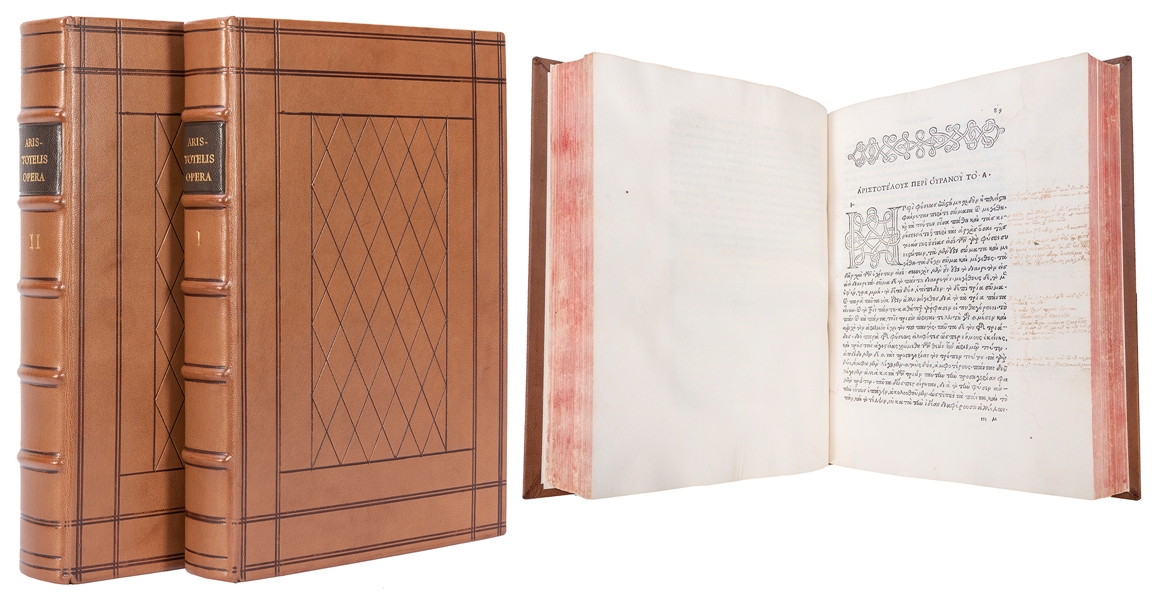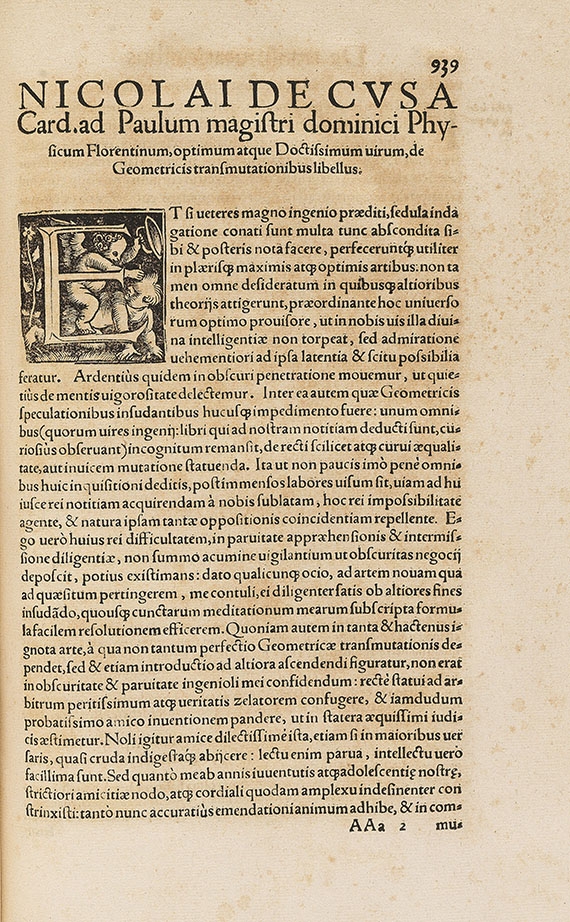ARISTOTLE (384-322 B.C.) De animalibus . Translated from Greek into Latin by Theodorus Gaza (ca. 1400-75), edited by Ludovicus Podocatharus. Venice: Johannes de Colonia and Johannes Manthen, 1476. Chancery 2 o (282 x 178mm). Collation: a-b 1 0 c-d 8 e-k 1 0 . 8 l-t 1 0 u 8 x 1 0 aa-dd 1 0 ee 8 ff 6 (a1 blank, a2r translator's preface addressed to Pope Sixtus IV, a7v De historia animalium , p1r De partibus animalium , u4r De generatione animalium , f4v colophon, f5r register, f5v-f6 blank). 250 leaves (of 252, without the first and final blanks). 35 lines. Type 8:109R. Initial spaces with printed guide-letters. (Faint waterstains in a few margins, a few other spots or stains.) 18th-century vellum over pasteboard (slight rubbing). Provenance : occasional 16th-century marginalia; 17th-century monastic ex-libris (effaced inscription, a2r); Charles de Brosses (1709-77), first president of the parlement de Bourgogne , author of treatises on geography and Antiquity (engraved armorial bookplate by Durand); "Bibliotheque de Laage, Ex libris Freycinet" (19th-century armorial ink stamp). FIRST EDITION of Aristotle's principal zoological works, the first collection of treatises on biology to be printed. " Historia animalium is an immense collection of biological data -- anatomical, physiological, behavioral -- on over five hundred species of animals. Aristotle's interest lay in identifying and classifying groups of animals and in explaining their functioning as a part of nature, and it was the data reported in Historia animalium that provided the basis for his philosophical analyses of relationships between structure, function, and purpose. In De partibus animalium he explored these 'links of causation' in the various groups of animals. In De generatione animalium he dealt with the principles of animal generation, including organs and secretions, gave a detailed account of generation in the different groups of animals, answered various questions connected with generation, and finally gave an explanation of development after birth and of the differences between individuals of the same species" (Grolier Medicine ). Theodore Gaza, who also translated the works of Theophrastus into Latin (see lot 204), worked under the patronage of Pope Nicholas V (1447-55), to whom his translation of De animalibus was at first dedicated. Later the dedication was transferred to Sixtus IV (1471-84), who was pope when the first edition was printed and for whom a splendidly illuminated presentation manuscript had been made (Vat. lat. 2094). Aldus Manutius praised Gaza as the leading classical scholar of his age, and recommended that a good way of learning Greek would be to study Gaza's Latin translation of De animalibus together with his own Greek text of the treatises, first published in the Aldine edition of Aristotle's works (see lot 21). Goff A-973; BMC V, 232 (IB. 20287); GW 2350; HC 1699*; IGI 803; Klebs 85.1; Osler Incunabula medica 106; Pellechet 1206; Polain 298; Proctor 4312; GM 274, 275, 462; Grolier Medicine 2A; Osler 239; Stillwell Science 573; Waller 16; Wellcome 425; Norman 69.
ARISTOTLE (384-322 B.C.) De animalibus . Translated from Greek into Latin by Theodorus Gaza (ca. 1400-75), edited by Ludovicus Podocatharus. Venice: Johannes de Colonia and Johannes Manthen, 1476. Chancery 2 o (282 x 178mm). Collation: a-b 1 0 c-d 8 e-k 1 0 . 8 l-t 1 0 u 8 x 1 0 aa-dd 1 0 ee 8 ff 6 (a1 blank, a2r translator's preface addressed to Pope Sixtus IV, a7v De historia animalium , p1r De partibus animalium , u4r De generatione animalium , f4v colophon, f5r register, f5v-f6 blank). 250 leaves (of 252, without the first and final blanks). 35 lines. Type 8:109R. Initial spaces with printed guide-letters. (Faint waterstains in a few margins, a few other spots or stains.) 18th-century vellum over pasteboard (slight rubbing). Provenance : occasional 16th-century marginalia; 17th-century monastic ex-libris (effaced inscription, a2r); Charles de Brosses (1709-77), first president of the parlement de Bourgogne , author of treatises on geography and Antiquity (engraved armorial bookplate by Durand); "Bibliotheque de Laage, Ex libris Freycinet" (19th-century armorial ink stamp). FIRST EDITION of Aristotle's principal zoological works, the first collection of treatises on biology to be printed. " Historia animalium is an immense collection of biological data -- anatomical, physiological, behavioral -- on over five hundred species of animals. Aristotle's interest lay in identifying and classifying groups of animals and in explaining their functioning as a part of nature, and it was the data reported in Historia animalium that provided the basis for his philosophical analyses of relationships between structure, function, and purpose. In De partibus animalium he explored these 'links of causation' in the various groups of animals. In De generatione animalium he dealt with the principles of animal generation, including organs and secretions, gave a detailed account of generation in the different groups of animals, answered various questions connected with generation, and finally gave an explanation of development after birth and of the differences between individuals of the same species" (Grolier Medicine ). Theodore Gaza, who also translated the works of Theophrastus into Latin (see lot 204), worked under the patronage of Pope Nicholas V (1447-55), to whom his translation of De animalibus was at first dedicated. Later the dedication was transferred to Sixtus IV (1471-84), who was pope when the first edition was printed and for whom a splendidly illuminated presentation manuscript had been made (Vat. lat. 2094). Aldus Manutius praised Gaza as the leading classical scholar of his age, and recommended that a good way of learning Greek would be to study Gaza's Latin translation of De animalibus together with his own Greek text of the treatises, first published in the Aldine edition of Aristotle's works (see lot 21). Goff A-973; BMC V, 232 (IB. 20287); GW 2350; HC 1699*; IGI 803; Klebs 85.1; Osler Incunabula medica 106; Pellechet 1206; Polain 298; Proctor 4312; GM 274, 275, 462; Grolier Medicine 2A; Osler 239; Stillwell Science 573; Waller 16; Wellcome 425; Norman 69.















Testen Sie LotSearch und seine Premium-Features 7 Tage - ohne Kosten!
Lassen Sie sich automatisch über neue Objekte in kommenden Auktionen benachrichtigen.
Suchauftrag anlegen